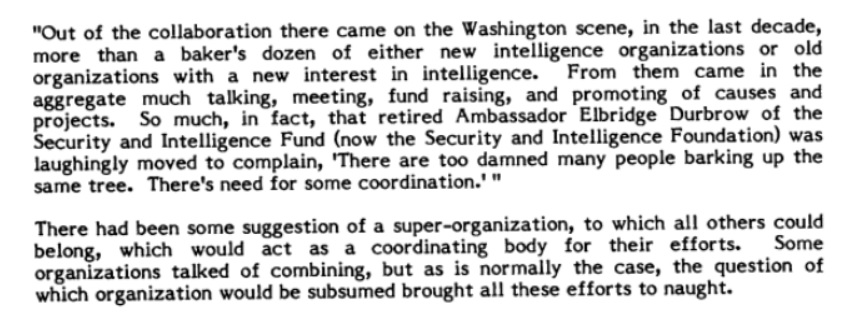Have You Ever Heard Of CIN — The Common Interest Network?
— WarNuse (@WarNuse) June 30, 2025
'CIN Is A Network. It Is Not An Organization. It Has No Charter, No List Of Officers, No By-Laws, No Regular Obligations, And It Does Not Contemplate Acquiring Any Or Developing Into A Distinct Legal Structural Entity. It… pic.twitter.com/9mXYwnU3N7
A document in Central Intelligence Retirees Association’s archive points to the existence of an unofficial “Common Interest Network” of retired intelligence officers. The network, also known as CIN - “as in living-in-sin” according to one of its founders - exists to coordinate the efforts of different organizations. Described as “an unofficial Intelligence Community,” it doesn’t exist except as an abstract, with no chairman, no agenda, and “not even the formality of a rotating host list.” Yet it exists, meeting to discuss influencing Congress and the press, to successfully attack the Freedom of Information Act, and to coordinate the efforts of the organizations that make up the Common Interest Network.

Captain Richard Bates, who was the president of two organizations making up the Common Interest Network, a board member on another three of its organizations, and the man who ran CIN for a time, wrote that it “is a network. It is not an organization. It has no charter, no list of officers, no bylaws, no regular obligations, and it does not contemplate acquiring any.” According to Ray Cline, a principle member of CIN, the acronym was appropriate because it would inevitably be pronounced “as in living-in-sin.” Captain Bates added that “CIN is a network … a loose, informal but regular gathering of representatives of the organizations with offices in the Washington area.”

According to Captain Bates and CIA historian Thomas Troy, CIN’s prehistory can be traced to a response to the “ceaseless round of accusations, investigations, revelations, and condemnations of the intelligence agencies.” The investigations conducted by Congress were explicitly cited as one of factors that lead to the creation of organization of organizations by retired intelligence officers. Some of these investigations into the wrongdoings of the intelligence agencies were seen, within the community, as threatening the Agency with its own personal Holocaust. The retired intelligence officers “found natural allies [in] retired military, defense specialists, some academicians, [and] public-spirit citizens.”

The result was, according to Thomas Troy, was “more than a baker’s dozen of either new intelligence organizations or old organizations with a new interest in intelligence.” This led to so much “talking, meeting, fund raising, and promoting of causes and projects” that retired Ambassador Durbrow finally called “for some coordination.” While there was some talk of a super-organization, or of combining organizations, these discussions largely went no where until the early 1980s.

During the National Military Intelligence Association’s (NMIA) 1981 convention, held at the National Defense University, leaders from four of the largest intelligence groups “discussed the profession, and particularly the role of their organizations.” Joined by the National Intelligence Study Center (NISC), the Association of Former Intelligence Officers (AFIO) and the Armed Forces Communications and Electronics Association (AFCEA), the groups were able to agree that “there could be no super-organization, but that there should be some sort of information coordinating effort.” They suggested “a periodic luncheon meeting” to make sure they all “barked in unison.”
read more:
https://www.muckrock.com/news/archives/2017/sep/21/cia-cin/

Replies